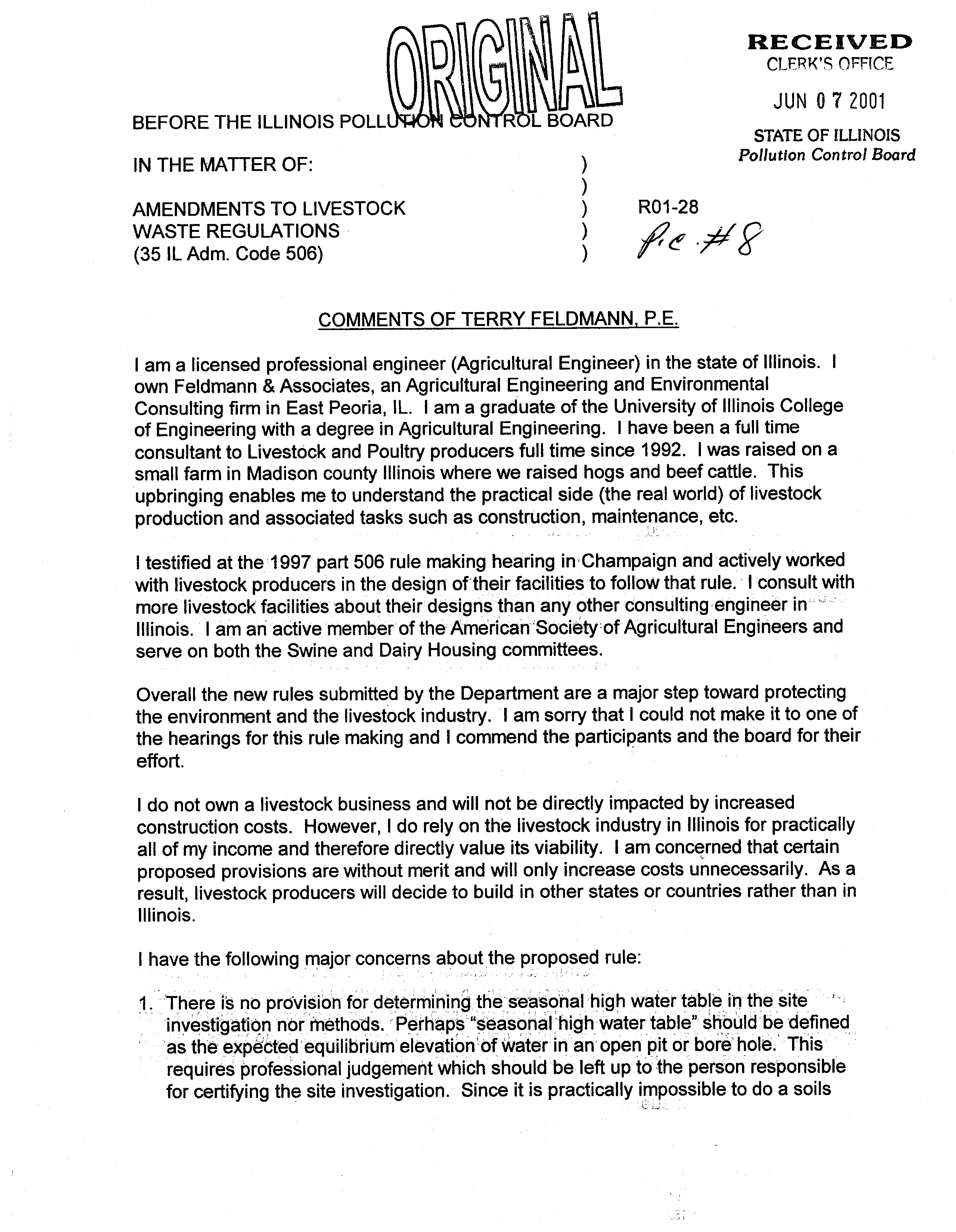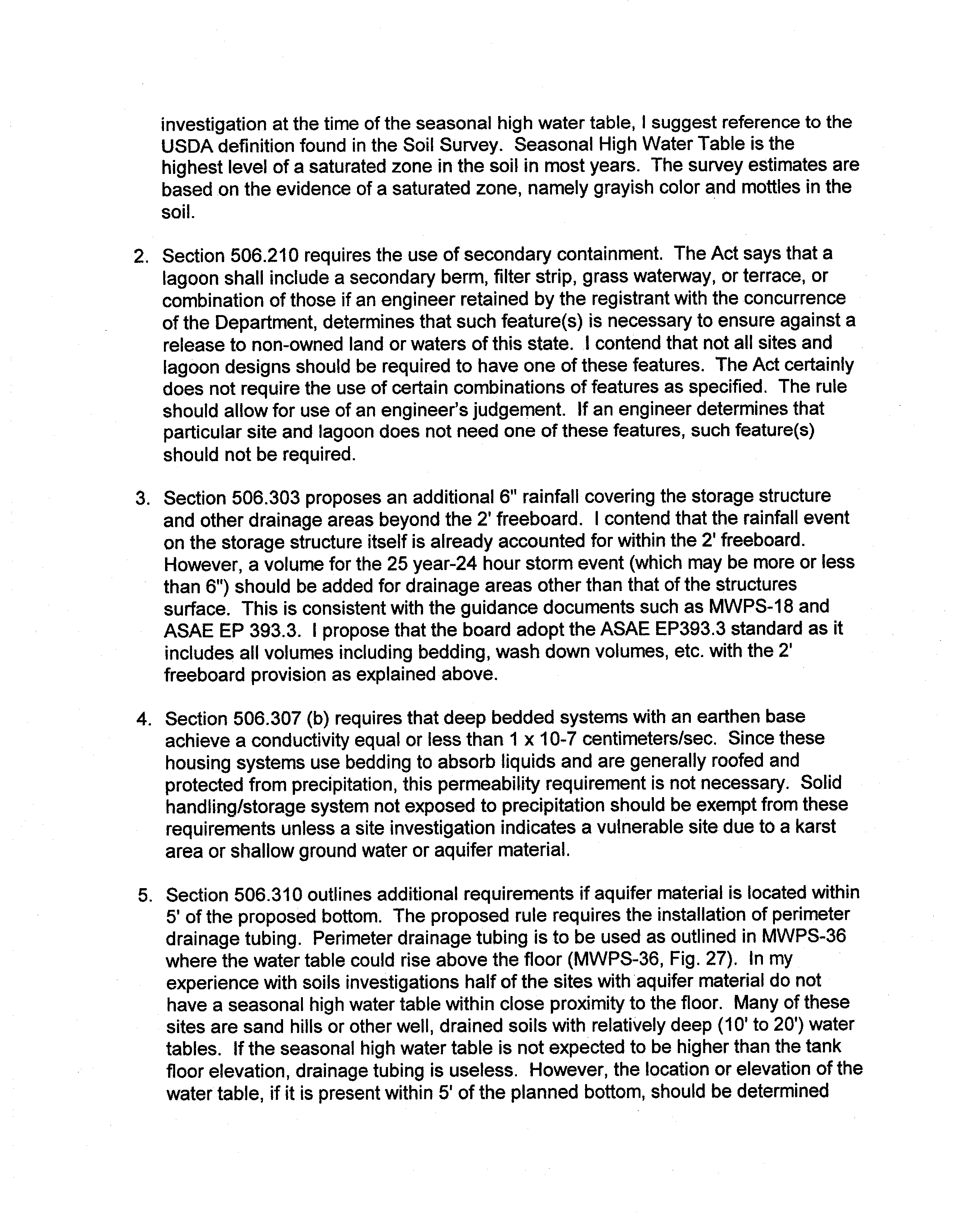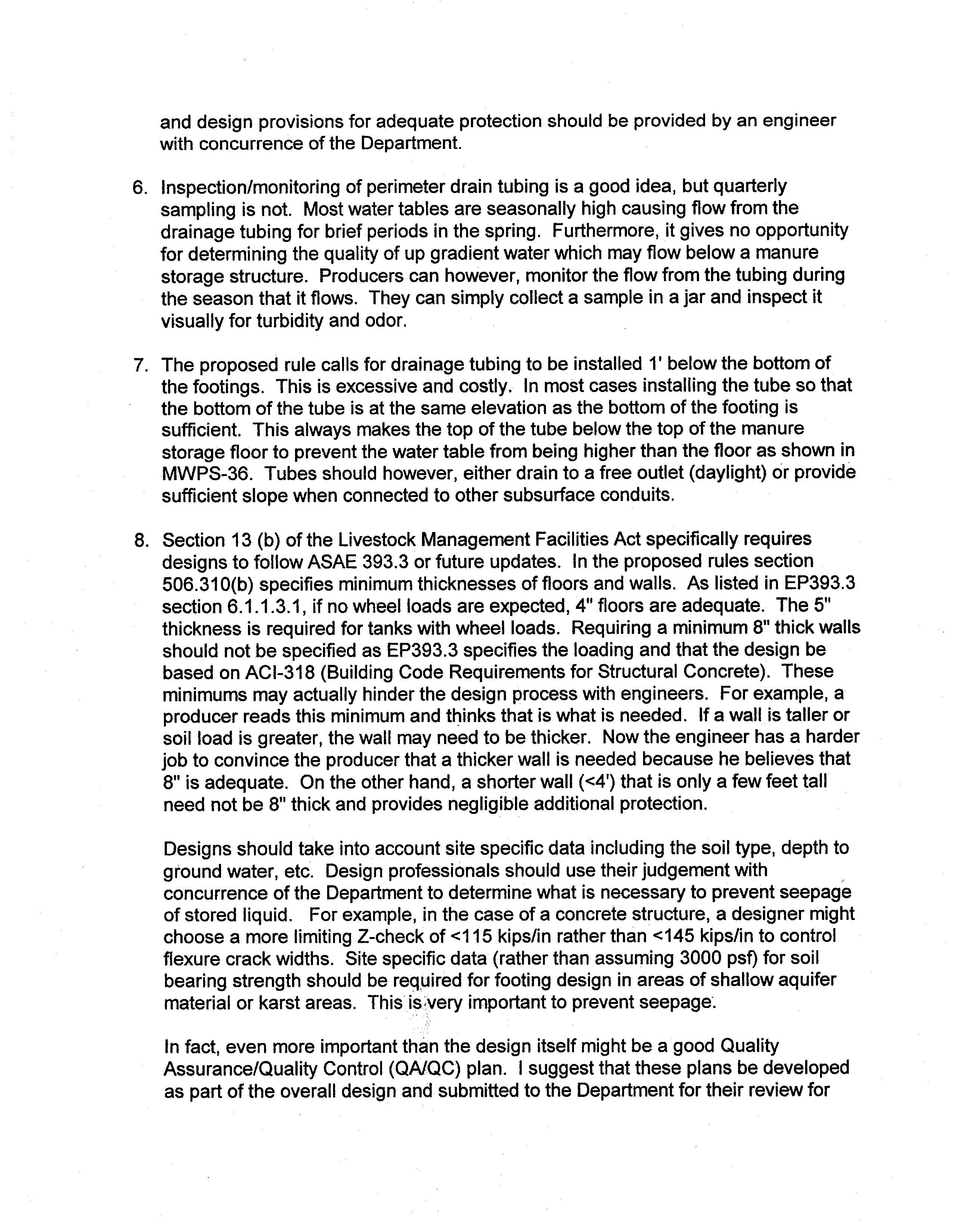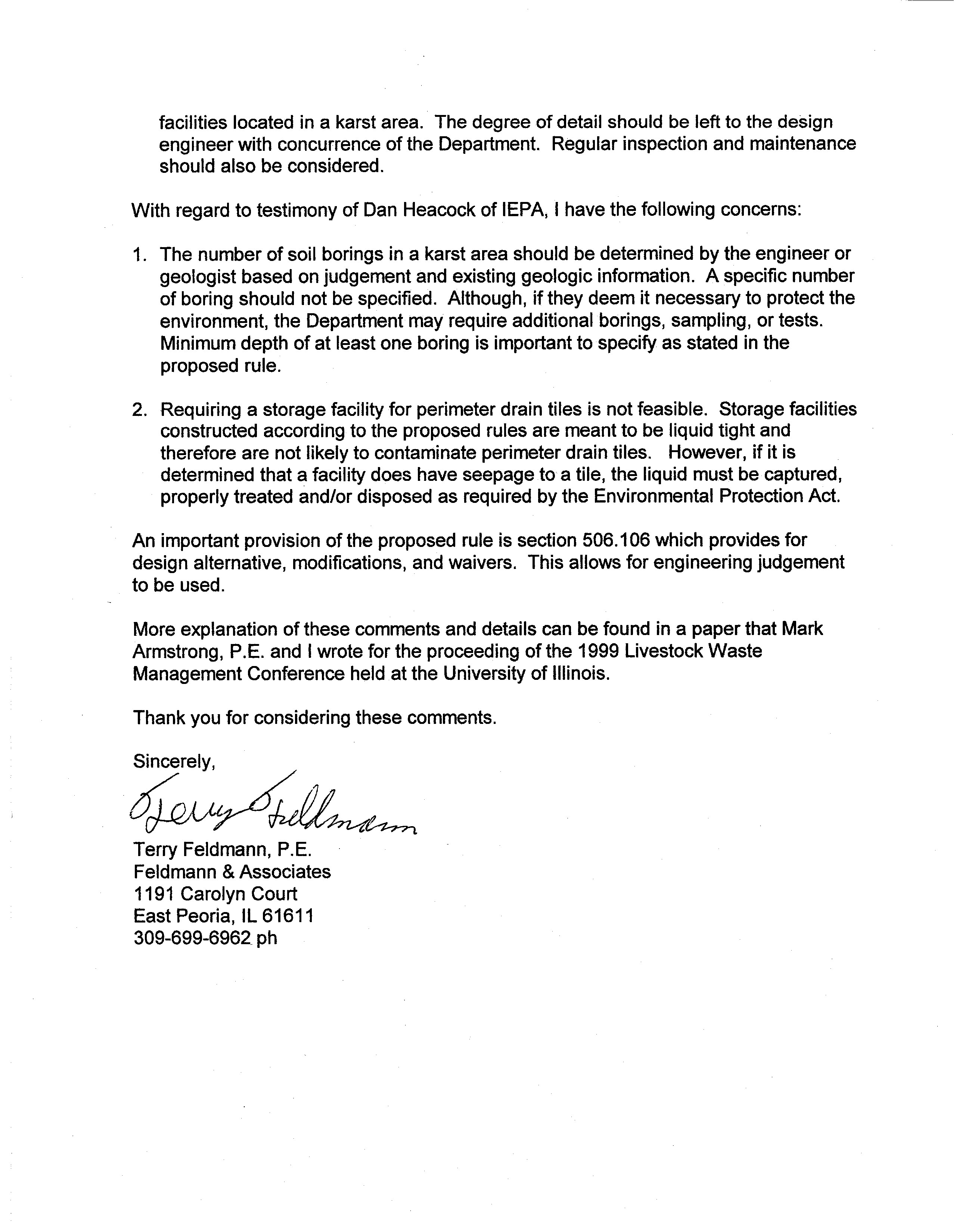RECEIVED
CLFR~<’~OFFICE
POLL~~R~
JUN
0 7
2001
BEFORE THE ILLINOIS
L BOARD
STATE
OF
ILLINOIS
IN
THE MATTER OF:
)
Pollution
Control Board
)
AMENDMENTS TO
LIVESTOCK
)
ROI-28
WASTE REGULATIONS
)
(35
IL Adm. Code 506)
)
COMMENTS OF TERRY FELDMANN.
P.E
I
am a licensed professional engineer (Agricultural Engineer) in the state of Illinois.
I
own Feldmann
& Associates, an Agricultural Engineering and Environmental
Consulting firm in
East Peoria,
IL.
I am a graduate of the University of Illinois College
of Engineering with a degree in Agricultural Engineering.
I
have been a full time
consultant to Livestock and Poultry producers full time since 1992.
I was raised
on a
small farm in Madison county Illinois where we raised
hogs and beef cattle.
This
upbringing enables
me to understand the practical
side (the real world) of livestock
production and associated tasks such as construction, maintenance, etc.
I testified at the 1997 part 506 rule making
hearing
in Champaign and actively worked
with livestock producers in the design of their facilities to follow that rule.
I consult with
more livestock facilities about their designs than any other consulting engineer in
Illinois.
I am an active member of the American SocietyofAgricultural Engineers and
serve on both the Swine and Dairy Housing committees.
Overall the new rules submitted by the Department are a major step toward
protecting
the environment and the livestock industry.
I am sorry that
I could not make it to one of
the hearings for this rule making and
I commend the participants and the board for their
effort.
I
do not own a livestock business and will not be directly impacted by increased
construction costs.
However,
I
do rely on the livestock industry
in Illinois for practically
all of my income
and therefore directly value its viability.
I am concerned that certain
proposed
provisions are without merit and will only increase costs unnecessarily.
As a
result,
livestock producers will decide to build in other states or countries rather than
in
Illinois.
I
have the following
major concerns about the proposed
rule:
1.
There is
no provision for determining the seasonal high water table in the site
investigation nor methods.
Perhaps “seasonalhigh water table”should
be defined
as the expected equilibrium elevation of water in an open pit or bore hole This
requires professional judgement which should be left up to the person responsible
for certifying the site investigation.
Since
it is practically impossible to do a soils
investigation at the time of the seasonal high water table,
I suggest reference to the
USDA definition found
in the Soil Survey.
Seasonal
High Water Table
is the
highest level of a saturated zone
in the soil
in most years.
The survey estimates are
based on the evidence of a saturated
zone, namely grayish
color and mottles
in the
soil.
2.
Section 506.210 requires the use of secondary containment.
The Act says that a
lagoon
shall include a secondary berm, filter strip, grass waterway, or terrace, or
combination of those if an engineer retained by the registrant with the concurrence
of the Department, determines that such feature(s) is necessary to ensure against a
release to non-owned
land or waters of this state.
I contend that not all sites and
lagoon designs
should be required to have one of these features. The Act certainly
does not require the use of certain
combinations of features as specified. The rule
should allow for use of an engineer’s judgement. If an engineer determines that
particular site and lagoon does not need one of these features, such feature(s)
should
not be required.
3.
Section 506.303 proposes an additional 6” rainfall covering the storage structure
and other drainage areas
beyond the 2’freeboard.
I
contend that the rainfall event
on the storage structure itself is already accounted for within the 2’freeboard.
However, a volume for the 25 year-24 hour storm event (which may be more or less
than 6”) should
be added for drainage areas other than that of the structures
surface.
This is consistent with the guidance documents such as MWPS-18 and
ASAE
EP 393.3.
I propose that the board adopt the ASAE EP393.3 standard as it
includes all volumes including bedding, wash down volumes, etc. with the 2’
freeboard provision as explained
above.
4.
Section 506.307
(b)
requires that deep bedded systems with an earthen base
achieve a conductivity equal
or less than I x 10-7
centimeters/sec.
Since these
housing systems
use bedding to absorb liquids and are generally roofed and
protected from precipitation, this permeability requirement is not necessary.
Solid
handlinglstorage system not exposed to precipitation should
be exempt from these
requirements unless a site investigation indicates
a vulnerable site due to a karst
area or shallow ground water or aquifer material.
5.
Section 506.310 outlines additional requirements if aquifer material
is located within
5’of the proposed
bottom. The proposed rule requires the installation of perimeter
drainage tubing.
Perimeter drainage tubing
is to be used as outlined
in MWPS-36
where the water table
could rise above the floor (MWPS-36, Fig.
27).
In my
experience with soils investigations half of the sites with aquifer material do not
have a seasonal
high water table within close proximity to the floor.
Many of these
sites are sand hills or other well, drained soils with relatively deep
(10’to 20’)water
tables.
If the seasonal high water table is not expected to be higher than the tank
floor elevation, drainage tubing
is useless.
However,
the location or elevation of the
water table, if it is present within 5’of the planned bottom, should
be determined
and design provisions for adequate protection should
be provided by an engineer
with concurrence of the Department.
6.
Inspection/monitoring of perimeter drain tubing
is a good
idea, but quarterly
sampling
is
not. Most water tables are seasonally high causing flow from the
drainage tubing for brief periods in the spring.
Furthermore,
it gives no opportunity
for determining the quality of up gradient water which may flow below a manure
storage structure.
Producers can however, monitor the flow from the tubing during
the season that
it flows.
They can simply collect a sample
in a jar and inspect it
visually for turbidity and odor.
7.
The proposed rule calls for drainage tubing to be installed
1’below the bottom of
the footings.
This is excessive and costly.
In most cases installing the tube so that
the bottom of the tube is at the same elevation as the bottom of the footing is
sufficient.
This always makes
the top of the tube below the top of the manure
storage floor to prevent the water table from being higher than the floor as shown in
MWPS-36. Tubes should however, either drain to a free outlet (daylight) or provide
sufficient slope when connected to other subsurface conduits.
8.
Section
13 (b) of the Livestock Management Facilities Act specifically requires
designs to follow ASAE 393.3 or future updates.
In the proposed rules section
506.310(b) specifies minimum thicknesses of floors and walls.
As listed in EP393.3
section 6.1.1.3.1, if no wheel loads are expected, 4” floors are adequate.
The 5”
thickness is required for tanks with wheel loads.
Requiring a minimum 8”thick walls
should
not be specified as EP393.3 specifies the loading
and that the design
be
based
on ACI-318 (Building Code Requirements for Structural Concrete).
These
minimums may actually hinder the design
process with engineers.
For example, a
producer
reads this minimum and thinks that is what is needed.
If a wall
is taller or
soil
load is greater, the wall
may need to be thicker.
Now the engineer has a harder
job to convince the producer that a thicker wall
is needed because he believes that
8” is adequate.
On the other hand,
a shorter waIl (<4’)that is only a few feet tall
need not be 8”thick and provides negligible additional protection.
Designs should take into account site specific data including the soil type, depth to
ground water,
etc.
Design professionals should use their judgement with
concurrence of the Department to determine what is necessary to prevent seepage
of stored liquid. For example,
in the case of a concrete structure, a designer might
choose a more limiting Z-check of <115 kips/in rather than <145 kips/in to control
flexure crack widths.
Site specific data (rather than assuming 3000 psf) for soil
bearing strength should be required for footing design
in areas of shallow aquifer
material or karst areas.
This is very important to prevent seepage.
In fact, even more important than
the design itself might be a good Quality
Assurance/Quality Control (QNQC)
plan.
I suggest that these plans be developed
as part of the overall design and submitted to the Department for their review for
facilities located
in a karst area.
The degree of detail should
be left to the design
engineer with concurrence of the Department.
Regular inspection and maintenance
should also be considered.
With regard to testimony of Dan Heacock of IEPA,
I have the following concerns:
1.
The number of soil borings in
a karst
area should
be determined
by the engineer or
geologist based
on judgement and existing geologic information.
A specific number
of boring should
not be specified. Although, if they deem
it necessary to protect the
environment, the Department may require additional borings, sampling, or tests.
Minimum depth of at least one boring is important to specify as stated
in the
proposed
rule.
2.
Requiring a storage facility for perimeter drain tiles is not feasible.
Storage facilities
constructed according to the proposed
rules are meant to be liquid tight and
therefore are not likely to contaminate perimeter drain tiles.
However, if it
is
determined
that a facility does have seepage to a tile, the liquid must be captured,
properly treated and/or disposed as required by the Environmental Protection Act.
An
important provision of the proposed
rule is section 506.106 which provides for
design alternative, modifications, and waivers.
This allows for engineering judgement
to be used.
More explanation of these comments and details can be found
in a paper that Mark
Armstrong,
P.E. and
I wrote for the proceeding of the 1999 Livestock Waste
Management Conference held at the
University of Illinois.
Thank you for considering these comments.
Sincerely,
Terry Feldmann,
P.E.
Feldmann
& Associates
1191
Carolyn Court
East Peoria,
IL 61611
309-699-6962 ph




